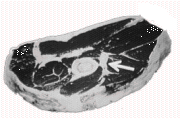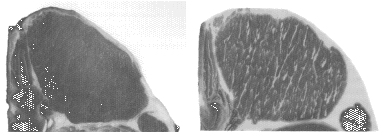Meat Quality Defects
The goal for improving quality and consistency of meat products has been adopted by may segments in the meat industry. Beef and pork producers have began to focus on producing products that are free of quality defects. Packers and processors also have emphasized production of consistent high quality products. Products with quality defects are an economic burden to the industry as a whole and in some cases result in discounts of market price to producers. The purpose of this lesson will be to identify and understand some of the quality defects of beef and pork that can be noted in the retail store.
Quality Defects of Beef
Dark-cutting Beef
Dark-cutting beef is an abnormally dark-colored lean. The color can range from a darker shade of cherry red to almost black. The meat has a sticky texture and a high water-holding capacity. Dark cutting beef results from low muscle glycogen at the time of slaughter which then produces meat that has a higher pH (closer to neutral) than normal meat (pH of about 5.5 to 5.6 or slightly acid.)
Dark-Cutting beef is rejected by consumers in the retail counter. Dark-cutting meat also will spoil more quickly than normal meat which results in a shorter shelf life in the retail counter. It is also regarded as having a less desirable flavor than normal pH beef, but us usually judged to be more tender and juicy.
Lack of Marbling
The amount of marbling in the USDA Standard Grade has been shown to have significantly less tenderness and is more variable in the tenderness. Carcasses that grade standard are severely discounted in market price.

Too Little Marbling
Excess Seam Fat
Fat on the outside of meat cuts can be trimmed and removed before eating. However, the fat that is located between the muscles, seam fat, cannot be easily trimmed. Most consumers select meat in the retail counter that has little visible fat. The production of excessively fat cattle not only have too much fat on the outside of cuts, but also accumulate too much seam fat.

Seam Fat
Too Large or Too Small Ribeyes
Ribeye size has an effect on the use of beef rib and loin steaks for steak cutting purveyors that supply restaurants. Steak are usually sold in restaurants based on weight, i.e., 6 ounces, 8 ounces or 12 ounces. To produce a 12-ounce steak from a small ribeye would require a thick cut steak while producing the same 12-ounce steak from a large ribeye would require a thin cut steak. The thin cut steak would cook more quickly than the thick cut steak, creating problems in food preparation.
Excessive External Fat
External fat can be trimmed from the cut of meat before eating, however, trimming of fat is expensive as product weight is lost and extra labor is required. Most consumers prefer cuts with less than 1/4 inch and many prefer to purchase cuts with all external fat trimmed.

External Fat
Quality Defects of Pork
Pale Soft and Exudative (PSE) Lean
Pale Soft and Exudative pork, PSE, is pork that does not have the normal reddish-pink color, is softer than normal pork that has a slight firm texture and has excessive weep or water loss. The unusual color causes some shoppers to avoid purchasing these products. PSE is also more susceptible to developing gray discoloration during display and the exudative lean produces excessive purge in the package during display. Hams produced from PSE muscle may have as much as a 7% lower processing yield.
Dark Firm and Dry Pork
Dark firm and dry, DFD, pork is the same problem as discussed in dark-cutting beef. As with beef, DFD pork is very dark in color and is less appealing to consumers. DFD lean is more susceptible to spoilage and has a short shelf life.
Too Much or Too Little Marbling
Although pork has always been considered a very tender meat, reducing the fat in pork chops has increased the concern about maintaining an threshold level of marbling in the chop to help assure eating qualities. At the opposite end of the spectrum, consumers are very concerned about fat and pork chops that have abundant amounts of marbling are also undesirable for the retail counter. Both too much and too little marbling are believed to discount the price of pork.

Too Little Marbling Too Much Marbling
Excess Seam Fat
Seam fat can be found in rib chops and blade steaks displayed in the retail counter. Seam fat is difficult to trim and consumers reject cuts that have large amounts of seam fat. Retail cuts that have excessive seam fat are usually mixed in packages of pork chops that have more acceptable levels of seam fat.
Too Much Color Variation in a Single Cut
Cuts of pork usually have different muscles and sometimes these muscles have a great variation in color. One muscle may have a light pink color while another muscle may be dark red. Consumers notice this variation in color and list it as a major concern when purchasing pork. Consumers believe that "fresh" pork is pinkish in color and not grey, brown or red.
Too Much External Fat
Excess external fat is one of the strongest visual cues for consumers to not select pork in the retail case. Excess external fat can be trimmed, however, the presence of external fat gives reinforces the perception of consumers that pork is "bad for you." Most consumers would expect pork cuts to be trimmed to 1/4 inch or less of external fat and may would expect cuts to be totally trimmed of fat.
Suggested Activities
- Plan a visit to a local retail store to observe the retail cuts in the counter. Have the students evaluate the retail cuts for any possible defects. Arrange for the meat counter manager to discuss the quality defects that he/she notices.
- Review the video tapes on Aiming for Quality Beef and Aiming for Quality Pork from the Total Quality Management (TQM) Curriculum for Youth Producers. Tapes and Leader activities are available from you local county extension office or can be ordered from Doyle Wolverton, Extension Youth Specialist in Animal Science, 402-472-6413.
- Contact someone from the local pork producers or beef producers group to address improving quality and consistency in their product.